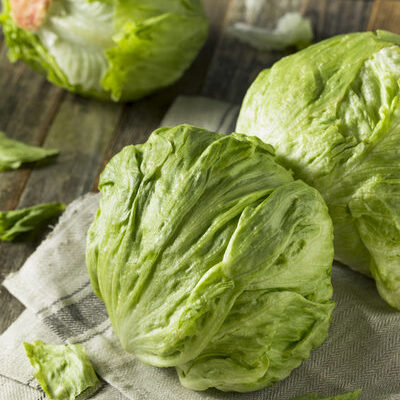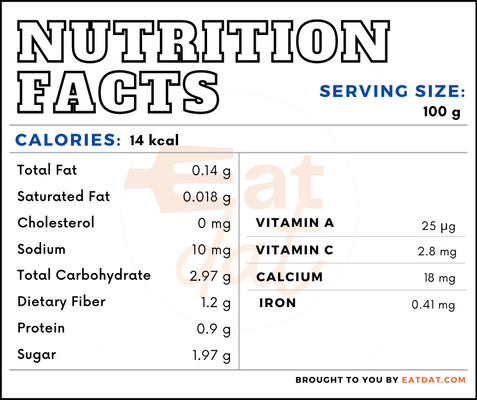
Iceberg Lettuce
also known as Crisphead Lettuce
What is Iceberg Lettuce?
Iceberg lettuce (Lactuca sativa) is a leafy vegetable that has pale green, crisp leaves and grows in round bulbs.
- This food is commonly used as a base for salads.
- Iceberg lettuce has also become a popular health food alternative for bread products in wraps and sandwiches.
The fact that this variety of lettuce is more affordable than others makes it even easier to find in supermarkets. A study found that in 2015 the average American consumed 25.8 pounds of lettuce with 51% of those being head lettuce.
The main varieties of iceberg lettuce grown in the United States are:
- Crispino
- Great Lakes
- Keeper
- Ithaca
- Maverick
- Raider
Origin of iceberg lettuce
This lettuce variety was developed in 1894 by the Burpee Seed Co. Although this lettuce variety was originally known as crisphead lettuce, by the 1930s its name had changed to iceberg lettuce. The name originated from the fact that this type of lettuce was transported cross-country using ice. Iceberg became ubiquitous by the 1940s with most people referring to it plainly as lettuce. Over time, this lettuce did lose some of its popularity to more nutritious varieties; however, it is still consumed far and wide to this day.
Nutrition
Because of its light flavor and crisp crunch, iceberg lettuce is most popularly used in dishes where other flavors can take center stage. While it may not be as nutritious as other leafy greens, this vegetable does provide some nutrients. The nutritional value of 100g iceberg lettuce:

As a low-calorie, low-fat, and sugar-free food, this lettuce can help craft a healthy and balanced diet. However, it’s recommendable to include a variety of vegetables that provide different vitamins and minerals. Dark greens, like spinach or red leaf lettuce, can also make up for the nutrients this vegetable lacks.
Commercial Production
The commercial production requires temperatures of 73°F (23°C) during the day and 45°F (7°C) at night. This crop also grows best in silt loams and sandy soils that offer proper drainage. While seedlings need to be sprinkled with water for the first 5-7 days, lettuce can be irrigated for the rest of the season with the majority of its watering happening in the final 30 days. Fertilization of iceberg lettuce crops helps balance out the level of nutrients in the soil, which may be imbalanced due to natural runoff caused by local weather. Once the lettuce is ready to harvest, it is packed into cartons on the field, then it is stored in a cool room until ready for sale.
Uses
This lettuce is well-known for its crisp crunch and subtle flavor that lends itself well to many dishes. Although to enjoy this leafy green to the fullest, it’s vital to store it properly. It’s best to wash and dry lettuce before storing it to ensure that it’s clean when you’re ready to use it. Once you’ve washed the iceberg lettuce, wrap it in a paper or cloth towel and place it in a bag to lock in moisture. When stored like this, the lettuce will stay fresh and crisp for up to 2 weeks.
Iceberg lettuce recipes
This vegetable is a common ingredient in many savory dishes. Here are some popular recipes:
- Classic Wedge Salad
- Stir-Fried Lettuce With Shrimp
- Iceberg, Parmesan, and Prosciutto Salad
- Grilled Chicken Caesar Salad
- Iceburgers
FDA Regulation
The Food & Drug Administration classifies all types of lettuces as raw agricultural commodities and regulates their harvesting, growing, packing, and holding. The FDA also has recommendations for how to handle iceberg lettuce and other leafy greens to minimize foodborne illnesses. This includes storing this food at the correct temperature, trimming to reduce pathogens, washing, and recommended time frames for storing leafy greens.
References
“Lettuce.” Agmrc.org, Agricultural Marketing Resource Center, Dec. 2018, www.agmrc.org/commodities-products/vegetables/lettuce.
“The History of Iceberg Lettuce.” Food History, Kitchen Project, kitchenproject.com/history/Salads_Lettuce/IceburgLettuce.htm.
“Tip of the Iceberg: Our Love-Hate Relationship With the Nation’s Blandest Vegetable.” Smithsonian.com, Smithsonian Institution, 26 Mar. 2013, www.smithsonianmag.com/arts-culture/tip-of-the-iceberg-our-love-hate-relationship-with-the-nations-blandest-vegetable-9074175/.
“Icerberg Lettuce Production in California.” Agriculture and Natural Resources, University of California, anrcatalog.ucanr.edu/pdf/7215.pdf.
